- September 29 – November 28, 2016 (The second half of the exhibition begins from November 3, 2016.)
- ANIMAL MASK OF AFRICA

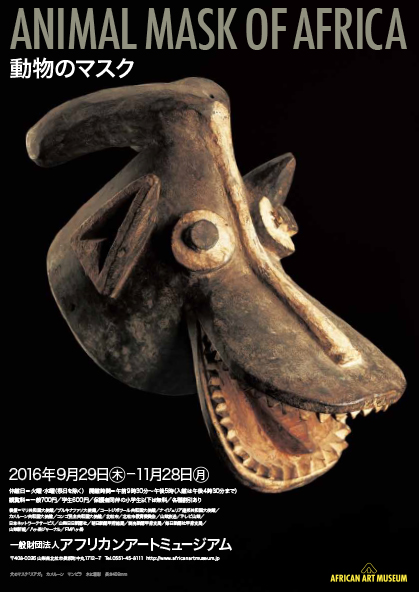
- In Africa, animals represented spirits or their messengers. Also, they were symbols of the royal family. Snakes represented the guardians of the Baga people in Guinea, the west Africa. Leopards and elephants were symbolized as the royal family of the Asante people in Ghana, the Benin empire in Nigeria, and the Bamileke people in Cameroon. In a myth of the Bobo people in Burkina Faso, a hornbill was said to be created by God before human being was created. Moreover, the Senufo people in Cote d’Ivoire believe that a hornbill is the messenger of God. Realistic animal sculptures of the European style are of course not seen in African art. Each animal’s characteristic parts have been exaggerated to look like these animals. Some animals’ parts have combined together to make a mask. Various forms of the animals have been expressed by each ethnic group. Therefore, we won’t be able to know the origin of these animals. Over several thousand years, totally unexpected and fantastic forms have been selected by each ethinic group and uniquely derived from their roots. This exhibition introduces various African masks which have animal themes.
- Nominal Support: Embassy of the Republic of Cote d'Ivoire, Embassy of the Federal Republic of Nigeria, Embassy of the Republic of Cameroon, Embassy of the Democratic Republic of the Congo, Embassy of Burkina Faso, Embassy of the Republic of Mali, Hokuto City, Hokuto City Board of Education, YBS Yamanashi Broadcast, Yamanashi Nichinichi Shinbun, The Asahi Shinbun Yamanashi-prefecture, The Mainichi Daily News Yamanashi prefecture, The daily Yomiuri Yamanashi prefecture, Yatsugatake Journal, and FM Yatsugatake.
- June 2 - September 26, 2016
- KINGS OF AFRICA
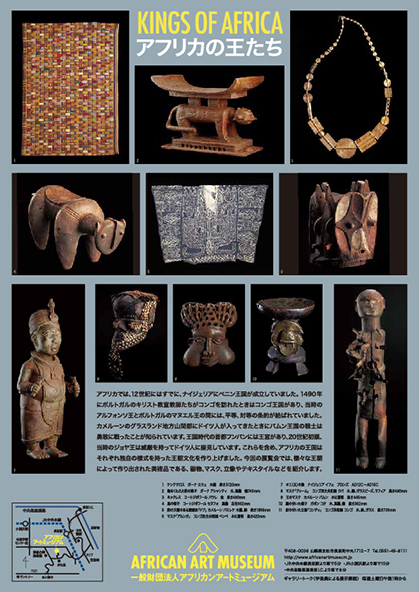
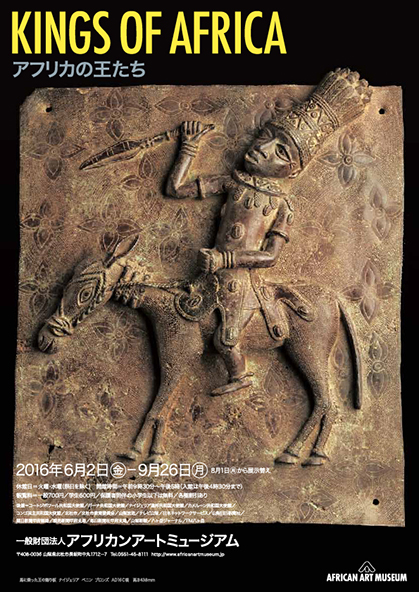
- The Benin kingdom of Nigeria has already established in 12th century. When Portuguese missionaries visited Congo in 1490, the Congo kingdom was already existed that King Alfons of Kongo(D.R Congo) and King Manuel of Portuguese had equal treaty between them. It is well known that worriers of the Bamum kingdom bravely fought with German soldiers when they invaded a mountain area of Cameroon grassland. During the Bamum kingdom era, kings’ palace was built in Foumban which was capital at the time. In early 20th century, King Njoya stately spoke to German. African kingdoms with all these histories of the kings created their own dynastic cultures. This exhibition introduces properties, masks, statues, textiles which related to kings.
- Nominal support: Embassy of the Republic of Cote d'Ivoire, Embassy of the Federal Republic of Nigeria, Embassy of the Democratic Republic of the Congo, Embassy of the Republic of Ghana, Hokuto City, Hokuto City Board of Education, YBS Yamanashi Broadcast, Yamanashi Nichinichi Shinbun, The Asahi Shinbun Yamanashi-prefecture, The Mainichi Daily News Yamanashi prefecture, The daily Yomiuri Yamanashi prefecture, Yatsugatake Journal, and FM Yatsugatake.
- April 1 - May 30, 2016
- EAT


- For humans, “Clothes”, “Food”, and “Shelter” are essential for our lives. Of these three, our most interests lie with “Food”. Every ethnic group in the world has their own unique food culture, which results in the existence of various kinds of tableware and tools. Moreover, each one of these groups conducts various ceremonies or rituals for prosperity, fertility, and rich harvests. Masks and statues were created for these ceremonies and rituals, which also are related to eating food. This exhibition introduces artworks, related to food from Africa, Oceania, Indonesia, and other Asian countries.
- Nominal Support: Embassy of the Republic of Cote d'Ivoire, Embassy of the Federal Republic of Nigeria, Embassy of the Democratic Republic of the Congo, Embassy of the Republic of Ghana, Embassy of Burkina Faso, Embassy of the Republic of Mali, Australian Embassy, Embassy of the Republic of Indonesia, Embassy of the Republic of Philippines, Embassy of Malaysia, Hokuto City, Hokuto City Board of Education, YBS Yamanashi Broadcast, Yamanashi Nichinichi Shinbun, The Asahi Shinbun Yamanashi-prefecture, The Mainichi Daily News Yamanashi prefecture, The daily Yomiuri Yamanashi prefecture, Yatsugatake Journal, and FM Yatsugatake.
- October 1 - November 30, 2015
- EARTH AND METAL

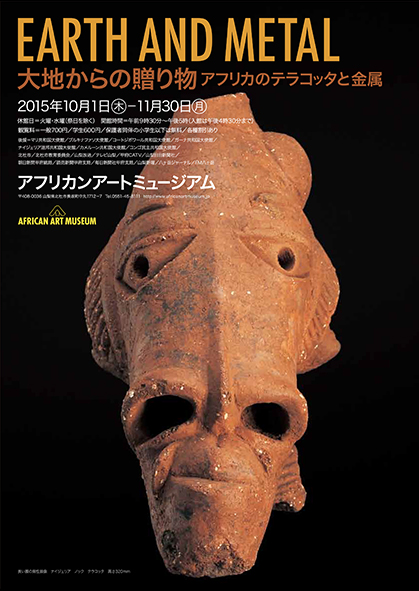
- The Nok culture prospered in Jose highland of the central Nigeria from 5th century BC to 3rd century AD. The sophisticated bronze culture of the Igbo-Ukwu became thrive at the Niger delta in 9th century AD. The Ife culture known as the only realistic sculptures in Africa appeared between the 10th and 15th century AD. In the same era, the culture of terra cotta and bronze prospered in Djenné, Mali. Therefore, 2500 years of the African art stream can be leaned from excavated terra cotta and bronze artworks. This exhibition mainly introduces the terra cotta artworks and bronze sculptures as well as brass or metal tools from each country of Africa.
- Nominal Support: Embassy of the Republic of Cote d'Ivoire, Embassy of the Federal Republic of Nigeria, Embassy of the Republic of Cameroon, Embassy of the Democratic Republic of the Congo, Embassy of the Republic of Ghana, Embassy of Burkina Faso, Embassy of the Republic of Mali, Hokuto City, Hokuto City Board of Education, YBS Yamanashi Broadcast, Yamanashi Nichinichi Shinbun, The Asahi Shinbun Yamanashi-prefecture, The Mainichi Daily News Yamanashi prefecture, The daily Yomiuri Yamanashi prefecture, Yatsugatake Journal, and FM Yatsugatake.
- June 4 - September 28, 2015
(The second half of the exhibition begins on August 1, 2015) - Lady in African Art

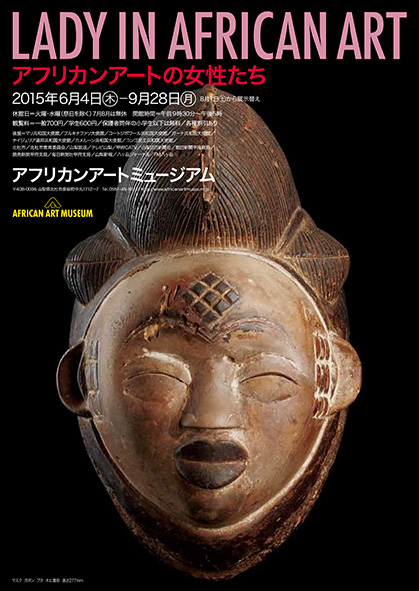
- Many female figures have made in Africa as the symbol of prosperities, fertilities, or invocations for the rich earth with dedications to the religious purposes. Because women give a birth to a child, they are called "Mothers of the origin" in some areas in Africa. It means that they are the creators of the people. Therefore, the royal family in matrilineal has made a large number of figures which represent its legitimacy. This exhibition introduces female figures, masks for playing as women, ornaments, or textiles.
- Nominal Support: Embassy of the Republic of Cote d'Ivoire, Embassy of the Federal Republic of Nigeria, Embassy of the Republic of Cameroon, Embassy of the Democratic Republic of the Congo, Embassy of Burkina Faso, Embassy of the Republic of Mali, Hokuto City, Hokuto City Board of Education, YBS Yamanashi Broadcast, Yamanashi Nichinichi Shinbun, The Asahi Shinbun Yamanashi-prefecture, The Mainichi Daily News Yamanashi prefecture, The daily Yomiuri Yamanashi prefecture, Yatsugatake Journal, and FM Yatsugatake.









